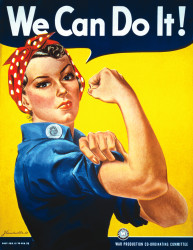 I attended a baby shower last week for a young woman who is expecting her first baby. As we munched on muffins and spinach quiche, the discussion meandered to a controversial subject—working mothers versus stay-at-home moms. The new mother-to-be, who was happily ripping open presents, won’t have to choose between the two. She has a job that she loves in her family’s business that will allow her to bring her little one to work with her. But the varying opinions of the other guests—ages 10 to 85—fascinated me. I was reminded of the research I did a few years ago for my novel, “A Woman’s Place.”
I attended a baby shower last week for a young woman who is expecting her first baby. As we munched on muffins and spinach quiche, the discussion meandered to a controversial subject—working mothers versus stay-at-home moms. The new mother-to-be, who was happily ripping open presents, won’t have to choose between the two. She has a job that she loves in her family’s business that will allow her to bring her little one to work with her. But the varying opinions of the other guests—ages 10 to 85—fascinated me. I was reminded of the research I did a few years ago for my novel, “A Woman’s Place.”
If I had asked the women at the shower to complete this once popular saying: “A woman’s place is . . .” I imagine only those who were baby-boomers or older would have known the answer: “A woman’s place is in the home.” Up until World War II, that’s where the majority of women in America were. But when war broke out and every able-bodied man in the nation marched off to do his duty, the call went out for women to take their places in the workforce. The women were nicknamed “Rosie the Riveters” and millions of them went to work in factories and shipyards and hangars for the duration of the war, building tanks and airplanes and aircraft carriers. Before that time, women were known as “the weaker sex” and no one believed they were capable of doing “men’s” work. Rosie proved them wrong and forever changed society’s perception of working women.
My novel tells the stories of four very different women who meet and become friends when they go to work in a shipyard in 1942. This is one of the pictures that inspired me: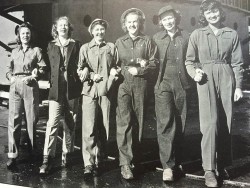
I asked my publisher to try to convey this wonderful sense of camaraderie and “we can do it” attitude on the book’s cover. I think they did a great job. (Don’t you love the shoes?)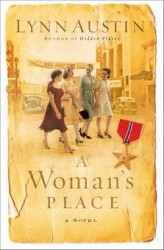
This is another picture that inspired me: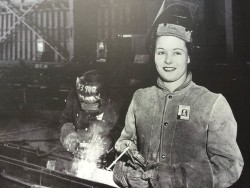
She could be “Leave it to Beaver’s” mom, an ordinary housewife who never imagined she could weld an airplane wing or operate a rivet gun or build a jet engine. But she did. And her brave efforts helped win the war. When it finally ended, Rosie and her fellow workers went back to their kitchens, letting the returning soldiers have “their” jobs back. Once again, the popular sentiment was “a woman’s place is in the home.” Rosie became Mom to an explosion of baby-boom children.
I graduated from high school in the late 1960s and wasn’t sure what I wanted to be. But I knew I wanted to go to college. “The best jobs for women are as nurses or teachers,” my high school guidance counselor advised. “You’ll only end up getting married and having children anyway.” Ouch! By the time my generation finished college, that attitude was beginning to change. “A women’s place is . . .” wherever she wants it to be.
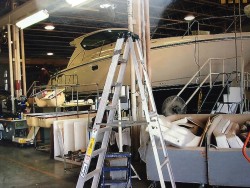 I toured three modern-day shipyards while doing my research and took this photo in one that builds yachts. Fully half of the employees were women, working side-by-side with men. I wondered if they knew how Rosie had paved the way for them.
I toured three modern-day shipyards while doing my research and took this photo in one that builds yachts. Fully half of the employees were women, working side-by-side with men. I wondered if they knew how Rosie had paved the way for them.
Like the expectant mom at the baby shower, my career as a writer means I didn’t have to choose between my family and my work. For most women, the choice isn’t that simple. But whatever path a young woman takes in the Twentieth Century, she can thank Rosie and the generation of women who did their part during World War II for opening the door wide to the range of opportunities she now enjoys.




1 comments
I loved the book a woman’s place by Lynn Austin and wondered if there is a sequel?
Comments are closed.